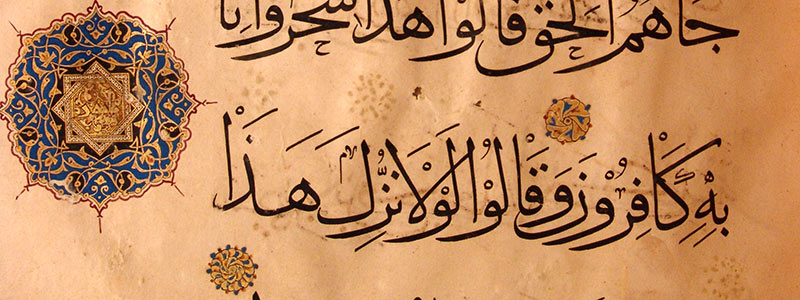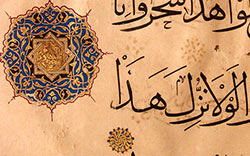Ahmad was born in Baghdad in 1256 CE. He was part of an notable ancestral lineage, which he introduced in a copy of Nahj al-Balāgha: he was Ahmad son of Yahyā son of Mohammad son of ‘Omar son of Ahmad from Sohravard. This short inscription indicates several things about his life, the most important being that he was probably Shi‘i (since Nahj al-Balāgha is a famous Shi‘i text attributed to the first Shi‘i Imām) and that, though he was born in Baghdad, he went out of his way to identify himself with a notable family with ancestral roots in Sohravard, a city between modern day Abhar and Zanjan, which is reflected in his signature, ‘Sohravardi’. He was taught calligraphy and music by Ebn Habib (d. 1284 CE) and Safi-al-Din Ormavi (d. 1293 CE). Some biographers believe that he was Yāqut Mosta‘sami’s (d. 1298 CE) student and have also ascribed a number of Arabic poems to him.
Although he has been praised for his skill in the Naskh and Thuluth scripts, he must also be counted among the most distinguished figures in the tradition of the Mohaqqaq script. His most beautiful and precious work, unparalleled by its peers, is the Qur’an written in the Mohaqqaq script (written between 701 AH/1301 CE-706 AH/1307 CE), four volumes of which are being kept at the National Museum of Iran. Thirty volumes of this work are in the endowment of the tomb of Shaykh Safi-al-Din Ardabili and a few others are held at museums in other countries. His earliest dated work is a single-page work of calligraphy written in 692 AH/1292 CE and his latest is a piece written in 730 AH/1329 CE, which is housed at the Süleymaniye Mosque in Istanbul. Ahmad passed away in 1340 CE and was buried in Baghdad.




